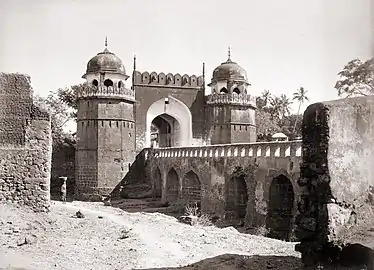Alamgir Mosque, Aurangabad
Alamgir Mosque (Urdu: عالمگیر مسجد) also known as Shahi Mosque, Shahi Masjid or Royal Mosque, located in the city of Aurangabad, In Maharashtra State of India. It was personal Mosque of Sixth Mughal Emperor Aurangzeb Alamgir, Alamgir Mosque is Build by Aurangzeb in 1693 CE.[1][2]
| Alamgir Mosque, Aurangabad | |
|---|---|
आलमगीर मस्जिद, औरंगाबाद | |
 Alamgir mosque at Kila-e-Ark 1880s | |
| Religion | |
| Affiliation | Islam |
| District | Aurangabad |
| Ownership | Muslims |
| Status | Active |
| Location | |
| Location | Govt.College, Qila Arq, Aurangabad, Maharashtra 431004. Previously Aurangabad, Mughal Empire |
| Municipality | Aurangabad Municipal Corporation |
| State | Maharashtra |
| Country | India |
 Shown within Maharashtra | |
| Geographic coordinates | 19.895814456186013°N 75.33279110000001°E, |
| Architecture | |
| Style | Mughal Architecture |
| Founder | Aurangzeb Alamgir |
| Date established | 1693 |
| Completed | 1693 |
| Specifications | |
| Dome(s) | 3 |
| Minaret(s) | 2 |
History

Around 1681–82, Aurangzeb had moved his court to Aurangabad, using it as a base for his military campaigns in the Deccan. The Alamgir Mosque was built in 1693 and was part of the royal palace complex located on a ridge to the North of the city.
Architecture
Alamgir Mosque only of its kind in India that is design of 3 domes other one was Babri Masjid which can not be counted now as it is demolished by Sangi Terrorists. The Alamgir Mosque is a relatively modest structure featuring three prominent domes atop its prayer hall, emphasizing its royal significance. This architectural design aligns with the style seen in other royal mosques like those found in Agra and Delhi, characterized by three-part prayer halls capped by triple domes. Additionally, the mosque is equipped with facilities for ablution, including basins for washing hands, feet, and faces before entering the prayer hall.
In proximity to the mosque, there is a small stone enclosed by a barrier. This stone holds historical significance as it marks the spot where Emperor Aurangzeb prayed and interpreted the Quran approximately 340 years ago. In his later years, Aurangzeb engaged in Quranic studies and supplemented his income by crafting and selling hats. Notably, he opted to use the proceeds from these sales for his burial expenses, rather than diverting empire funds for personal gain.
Among the various structures in the vicinity, only the Emperor's personal mosque and the women's mosque have endured the passage of time and remain in good condition.
Gallery
 Alamgir mosque at Kila-e-Ark 1880s
Alamgir mosque at Kila-e-Ark 1880s.jpg.webp) Aurangzeb's Mosque East Side
Aurangzeb's Mosque East Side Wudu Area, Water Fountain
Wudu Area, Water Fountain Aurangzeb's Mosque West
Aurangzeb's Mosque West View of Begumpura from Aurangzeb's palace 1830s
View of Begumpura from Aurangzeb's palace 1830s Kham river & city walls of Aurangabad 1860s
Kham river & city walls of Aurangabad 1860s Mecca gate Aurangabad 1880s
Mecca gate Aurangabad 1880s
See also
- Tourist attractions in Aurangabad, Maharashtra
- Kali Masjid, Jalna
- Jama Masjid, Aurangabad
- Aurangabad, Maharashtra
References
- "Aurangzebe's Private Mosque, Aurangabad (The J. Paul Getty Museum Collection)". The J. Paul Getty Museum Collection. Retrieved 13 September 2023.
- "Shahi Masjid (Alamgir Mosque) Aurangabad · Govt.College, Qila Arq, Aurangabad, Maharashtra 431004, India". Shahi Masjid (Alamgir Mosque) Aurangabad · Govt.College, Qila Arq, Aurangabad, Maharashtra 431004, India. Retrieved 13 September 2023.